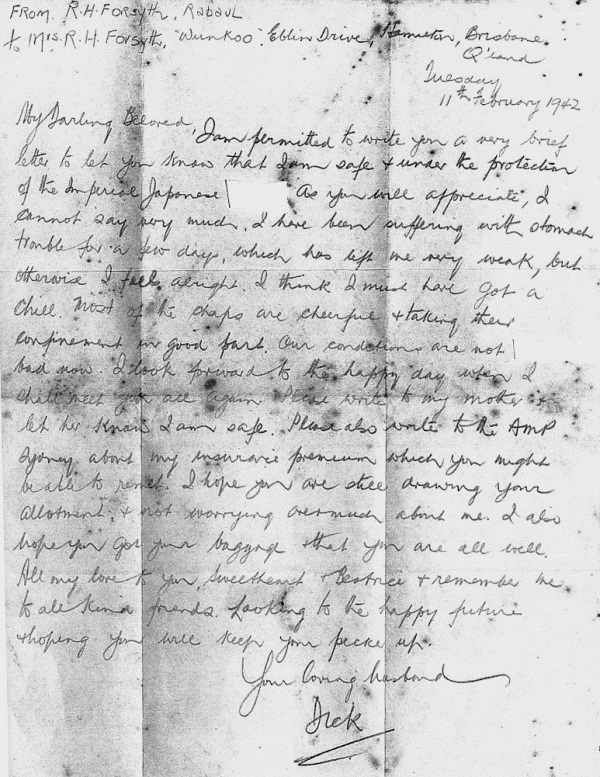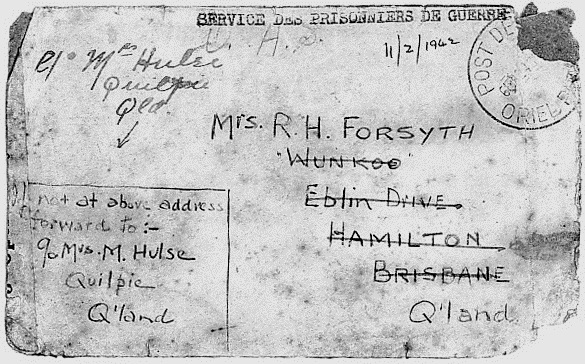ROLAND NOEL HARRISON FORSYTH
My father, Dick Forsyth, officially known as RH Forsyth (not liking name Noel) was taken prisoner as a civilian and drowned at sea on the Montevideo Maru, I July 1942. I have the original letter stating this (enclosed is a photocopy) from the Department of External Territories dated 14th December 1945. He was forty five.
He was an accountant and became company Secretary to Peadon’s Garage in Rabaul. Also, when Gordon Thomas, editor of the Rabaul Times was away, his second in charge, Mr Hoogerwerff asked Dick to write the ‘leaders’ for the newspaper.
My father was a fairly tall, slim, quiet man who, although he had a fine sense of humour, took his family responsibilities seriously, I have been told. He taught me to swim in the Rabaul baths and to ride my little bike round our garden. I remember him with love and a sense of his solidness. I only knew him for six years before my mother Gladys Forsyth and I were evacuated on the Macdhui.
From notes written by my mother of her life in the islands, I discovered that my father had left Sydney to go to New Guinea to manage a coconut plantation outside Kavieng, one of many plantations in the islands offered to World War 1 returned soldiers by the Australian Government. Eventually he came to live and work in Rabaul because of frequent malaria attacks, which required hospitalisation. He met my mother, then Gladys Field, who was a Nursing Sister, at the Namanula Hospital for Europeans. Her friends called her “Paddy” ! They were married in 1933.
Dick Forsyth joined the newly formed New Guinea Volunteer Rifles as a Gunner, however malaria weakened his body, and he was honourably discharged from the NGVR sometime early in 1941. Years later when my mother requested his service number, the War Veteran’s Department could not find any record of it. In 1992 I was told that all the early numbers were lost or destroyed in the bombings on Rabaul. I was told the NGVR was formed in October/November 1939 and after a while many of the men left to join the AIF and were sent to Africa, so the Deputy Administrator at Rabaul, Harold Page, who was organising the NGVR, decided that as the numbers were then out of any sequence he would start numbering from the number 2000.
I have no recollection of the date of his birth, however, I have my Mother’s marriage certificate with my father’s year of birth as 1897. The month was possibly October, as my Mother, whose birthday was 2/4/1897, told me he was six months younger than herself.
How this affected my family
I was the only child of Gladys Mary Jesse Beatrice Forsyth and Roland Noel Harrison Forsyth. Being so young (I had just turned seven early in November 1941) the whole evacuation was, for me, one of excitement. I don’t remember saying ‘goodbye’ to my father, never imagining this was to be the last time I’d see him.
I do remember how silent my mother was in those early days. I never heard her laugh, or even reprimand me. In some of her written notes she describes how she and one of her friends, and I quote, “went to the Station to meet every train that came in, in the hopes that our husbands would be on one of them. One day her friend’s husband was. . .”
How we heard about the tragedy of the Montevideo Maru
I have only two pages of pencilled notes my mother wrote of the first news she had of the fate of her husband. This was from a Captain Peter Brown on ‘November 4th Sunday’.
It was 1945. The notes started with ‘Captain Peter Brown came this afternoon on the 3.30 bus with his wife Clarice. He told me about the time the prisoners had in Rabaul.
He was in the next hut to Dick. In Dick’s hut was Gascoigne and his son Ivor and Renton, Jan Hoogerwerff, Symes and I think he said some Norwegian sailors from that ship the ‘Herstein’.
‘…even when they were told to go on the boat they thought they were being moved away because the Americans were coming.’ … ‘They took on large supplies of rice and firewood. He often talked with Dick, and said he was alright.’ End of notes.
Evacuation
I was evacuated with my mother on the ship the Macdhui. I remember standing in a large park or the Botanical Gardens in Rabaul, with a lot of other people, and hearing a booming voice say over the loud speaker, ‘you have twenty four hours to pack’.
My mother packed all she could, of value, into the carved camphorwood box she and my father had bought on their honeymoon in Shanghai. (It takes pride of place in my house.) I was allowed to bring my bike on board to go in the cargo hold. I remember the steep, slippery gangway onto the ship.
My mother told me that she and her cabin companion were sea sick for the whole trip; however, her two children and I were not, so the grown-ups spent most of the time up on the deck looking after each other’s children or on the bunk, wanting to die, no doubt! I don’t remember Christmas on board ship.
The Macdhui took us to Townsville where we disembarked and boarded a train for Brisbane, to stay with my grandmother. I remember the first sight of my grandmother. She was a tall, stately lady with a halo of white hair and wearing a black skirt, white blouse and black stockings. She looked kind, and I remember feeling safe. She had been living in Ferny Grove, a suburb on the outskirts of Brisbane, which she sold to rent a flat in Hamilton close to the Hamilton Wharf. This enabled her to catch a taxi to meet my mother and I when we came off the ship. My little bike that my father had taught me to ride on, was stolen out of the hold of the ship, I never saw it again.
The short-term and long-term challenges
The short term effect was that food rationing coupons were distributed. My grandmother would have had to support us financially, I assume, till my mother found a job. We stayed in Hamilton for six months before moving to a rented house in Stanthorpe, which was behind the ‘Brisbane Line’ where we were supposed to be safe from attacks or invasion by the Japanese.
We lived in Stanthorpe for a year and a half where my mother, being a well-qualified Nursing Sister, applied for a job at a Nursing Agency. She was employed as a specialist nurse for post-op care of the wife of a property owner in Dalveen, outside Stanthorpe, who had had a major operation. My mother had to live-in, not having any mode of transport, with a day off each weekend. This position gave her an income from June 1942 till we left early in 1944 to rent a house in South Brisbane and so that I could continue at Somerville House when the school moved from Stanthorpe back to South Brisbane.
ln 1944 my mother took up a position in the Casualty Department at the Royal Brisbane (then the Brisbane General Hospital.) In 1945 she purchased an old ‘Queenslander’ in Taringa, Brisbane. I think the money came from compensation from the War Dept. She lived there for fifty years only leaving for nursing positions out west and overseas, at various times. She never married again, and died in 2003 at the age of one hundred and six.
My feelings continuing to this day
In 2005, when in my early seventies, I become conscious of deeply buried emotions of anger and resentment. With help from some very special, qualified counsellor friends I realised the emotions turned out to be about the war that took my father and the fact that I had not said goodbye to him. Also that my mother became uncommunicative. The healing has taken the last five years.
In the last few months of 2011, hearing about the Montevideo Maru Society’s aim to have a memorial erected at one of the most renowned places in Australia, the Australian National War Memorial, emotions of incredible sadness and the horror and uselessness of war overwhelmed me again. However this was short lived and the love and honour of this memorial has helped me realise I have arrived at a closure.
However, I felt I needed to share more of the story with my family and give them a chance to attend the dedication of the Rabaul and Montevideo Memorial on July 1st this year, if they wish. After all it is vital history, being Australia’s greatest maritime disaster.
I am sincerely grateful for the efforts of the men and women who have dedicated their time and money to achieve this outstanding memorial. I thank the Sculptor James Parrett for his magnificent idea and his work.
And congratulations to the Rabaul and Montevideo Maru Society for the wonderful work that is being done to accomplish the goal of erecting the Rabaul & Montevideo Maru Memorial at the Canberra War Memorial.
I feel I have honoured my father’s life and his sacrifice in many ways…also by attending the 50th Anniversary in Rabaul in June 1992,with the 2/22’d Lark Force survivors and the families of the civilian prisoners on the Montevideo Maru.
I enclose photocopies of some relevant documents received by my mother.



